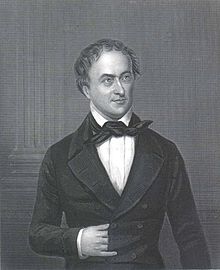Heinrich Rose
Heinrich Rose (born August 6, 1795 in Berlin , † January 27, 1864 in Berlin) was a German mineralogist , analytical chemist and (re-) discoverer of the chemical element niobium . He was the son of Valentin Rose the younger and brother of Gustav Rose .
Life
Heinrich Rose came from a family of merchants and scholars from the Brandenburg region . After the death of his father, the chemist Martin Heinrich Klaproth took over his upbringing and that of his brother . After completing his apprenticeship as a pharmacist , Rose was trained as a chemist by Jöns Jakob Berzelius from 1819 to 1821 . Shortly thereafter, in 1822, he became a lecturer in chemistry at the University of Berlin . From 1835 he was a full professor of chemistry in Berlin.
His grave was in the St. Marien and St. Nikolai Cemetery I in the Berlin district of Prenzlauer Berg .
Act
In 1844 he was able to prove that niobium and tantalic acid are different substances. Tantalum was already known; he named the new, similar element niobium, after Niobe , daughter of tantalus.
Rose had no knowledge of this work by Charles Hatchett in the year 1801. This was believed that columbite - ore contains a single unknown element, which he named columbium was. In reality, columbite contains the two metals niobium and tantalum, among other elements. Another unknown metal that Rose believed to have found in Bavarian tantalite, and which he called pelopium , later turned out to be niobium.
Rose was one of the leading analysts of the 19th century. His handbook of analytical chemistry , which appeared in 1829, had numerous editions. In addition to the discovery of the element niobium, he researched the chemistry of the element titanium . In December 1848, when the German Geological Society was founded, he was one of the 49 participants in the constituent meeting.
Honors
In 1829 he was accepted as a corresponding member of the Russian Academy of Sciences in Saint Petersburg . In 1832 he became a member of the Prussian Academy of Sciences . In 1835 he was appointed a foreign member of the Bavarian Academy of Sciences . In 1843 he became a corresponding member of the Académie des sciences , in 1849 he was elected to the American Academy of Arts and Sciences . In 1856 he was elected a corresponding member of the Göttingen Academy of Sciences and in 1860 a member of the German Academy of Natural Scientists Leopoldina . In addition, on May 31, 1861, he was accepted into the Prussian order Pour le Mérite for science and the arts .
Work
- Handbook of analytical chemistry
- Composition of the Columbits & Samarskits in Academic Monthly Reports , Berlin 1862.
literature
- Richard Anschütz : Rose, Heinrich . In: Allgemeine Deutsche Biographie (ADB). Volume 29, Duncker & Humblot, Leipzig 1889, pp. 177-181.
- Hans-Werner Schütt : Rose, Heinrich. In: New German Biography (NDB). Volume 22, Duncker & Humblot, Berlin 2005, ISBN 3-428-11203-2 , p. 44 ( digitized version ).
Web links
Individual evidence
- ↑ Pelopium. In: Concise dictionary of pure and applied chemistry. Edited by J. Liebig, JC Poggendorff u. Ms. Wöhler. Braunschweig 1854, vol. 6, p. 130 Digitized in the Google book search
- ^ Foreign members of the Russian Academy of Sciences since 1724. Heinrich Rose. Russian Academy of Sciences, accessed October 20, 2015 .
- ↑ Member entry of Heinrich Rose (with picture) at the Bavarian Academy of Sciences , accessed on June 23, 2016.
- ^ List of members since 1666: Letter R. Académie des sciences, accessed on February 23, 2020 (French).
- ↑ Holger Krahnke: The members of the Academy of Sciences in Göttingen 1751-2001 (= Treatises of the Academy of Sciences in Göttingen, Philological-Historical Class. Volume 3, Vol. 246 = Treatises of the Academy of Sciences in Göttingen, Mathematical-Physical Class. Episode 3, vol. 50). Vandenhoeck & Ruprecht, Göttingen 2001, ISBN 3-525-82516-1 , p. 205.
- ↑ Heinrich Rose's membership entry at the German Academy of Sciences Leopoldina , accessed on June 23, 2016.
- ↑ THE ORDER POUR LE MERITE FOR SCIENCE AND ARTS, The Members of the Order Volume I (1842–1881), page 230, Grbr. Mann_verlag, Berlin 1975
| personal data | |
|---|---|
| SURNAME | Rose, Heinrich |
| BRIEF DESCRIPTION | German mineralogist, analytical chemist and the discoverer of the chemical element niobium |
| DATE OF BIRTH | August 6, 1795 |
| PLACE OF BIRTH | Berlin |
| DATE OF DEATH | January 27, 1864 |
| Place of death | Berlin |

